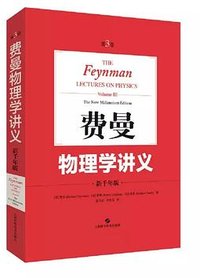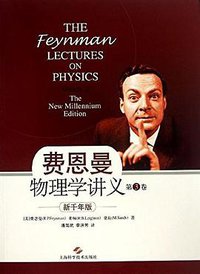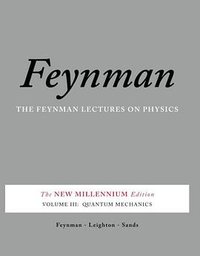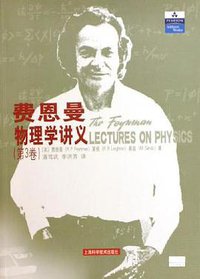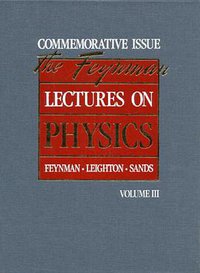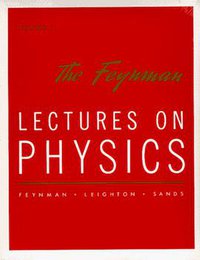费恩曼物理学讲义 (第3卷)(英文版)
Douban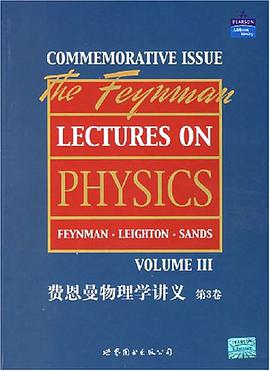
第三卷·英文版
Richard P. Feynman / Robert B. Leighton …
Übersicht
A great triumph of twentieth-century physics, the theory of quantum mechanics, is now nearly 40 years old, yet we have generally been giving our students their introductory course in physics (for many students, their last) with hardly more than a casual allusion to this central part of our knowledge of the physical world. We should do better by them. These lectures are an attempt to present them with the basic and essential ideas of the quantum mechanics in a way that would, hopefully, be comprehensible. The approach you will find here is novel, particularly at the level of a sophomore course, and was considered very much an experiment. After seeing how easily some of the students take to it, however, I believe that the experiment was a success. There is, of course, room for improvement, and it will come with more experience in the classroom. What you will find here is a record of that first experiment. .
In the two-year sequence of the Feynman Lectures on Physics which were given from September 1961 through May 1963 for the introductory physics course at Caltech, the concepts of quantum physics were brought in whenever they were necessary for an understanding of the phenomena being described. In addition, the last twelve lectures of the second year were given over to a more coherent introduction to some of the concepts of quantum mechanics. It became clear as the lectures drew to a close, however, that not enough time had been left for the quantum mechanics. As the material was prepared, it was continually discovered that other important and interesting topics could be treated with the elementary tools that had been developed. There was also a fear that the too brief treatment of the Schrodinger wave function which had been included in the twelfth lecture would not provide a sufficient bridge to the more conventional treatments of many books the students might hope to read. It was therefore decided to extend the series with seven additional lectures; they were given to the sophomore class in May of 1964. These lectures rounded out and extended somewhat the material developed in the earlier lectures.
contents
chapter 1. quantum behavior .
1-1 atomic mechanics 1-1
1-2 an experiment with bullets 1-1
1-3 an experiment with waves 1-3
1-4 an experiment with electrons 1-4
1-5 the interference of electron waves 1-5
1-6 watching the electrons 1-6
1-7 first principles of quantum mechanics 1-9
1-8 the uncertainty principle 1-11
chapter 2. the relation of wave and particle viewpoints
2-1 probability wave amplitudes 2-1
2-2 measurement of position and momentum 2-2
2-3 crystal diffraction 2-4
2-4 the size of an atom 2-5
2-5 energy levels 2-7
2-6 philosophical implications 2-8
chapter 3. probability amplitudes
3-1 the laws of combining amplitudes 3-1
3-2 the two-slit interference pattern 3-5
3-3 scattering from a crystal 3-7
.3-4 identical particles 3-9
chapter 4. identical particles
4-1 bose particles and fermi particles 4-1
4-2 states with two bose particles 4-3
4-3 states with n bose particles 4-6
4-4 emission and absorption of photons 4-7
4-5 the blackbody spectrum 4-8
4-6 liquid helium 4-12
4-7 the exclusion principle 4-12
chapter 5. spin one
5-1 filtering atoms with a stern-gerlach apparatus 5-1
5-2 experiments with filtered atoms 5-5
5-3 stern-gerlach filters in series 5-6
5-4 base states 5-8
5-5 interfering amplitudes 5-10
5-6 the machinery of quantum mechanics 5-12
5-7 transforming to a different base 5-15
5-8 other situations 5-16
chapter 6. spin one-htlf
6-1 transforming amplitudes 6-1
6-2 transforming to a rotated coordinate system 6-3
6-3 rotations about the z-axis 6-6
6-4 rotations of 180~ and 90~ about y 6-9
6-5 rotations about x 6-11
6-6 arbitrary rotations 6-12
chapter 7. the dependence of amplitudes on time
7-1 atoms at rest; stationary states 7-1
7-2 uniform motion 7-3
7-3 potential energy; energy conservation 7-6
7-4 forces; the classical limit 7-9
7-5 the "precession" of a spin one-half particle 7-10
chapter 8. the hnmiltonian matrix
8-1 amplitudes and vectors 8-1
8-2 resolving state vectors 8-3
8-3 what are the base states of the world ? 8-5
8-4 how states change with time 8-7
8-5 the hamiltonian matrix 8-10
8-6 the ammonia molecule 8-11
chapter 9. the ammonia maser
9-1 the states of an ammonia molecule 9-1
9-2 the molecule in a static electric field 9-5
9-3 transitions in a time-dependent field 9-9
9-4 transitions at resonance 9-11
9-5 transitions off resonance 9-13
9-6 the absorption of light 9-14
chapter 10. other two-state systems ..
10-1 the hydrogen molecular ion 10-1
10-2 nuclear forces 10-6
10-3 the hydrogen molecule 10-8
10-4 the benzene molecule 10-10
10-5 dyes 10-12
10-6 the hamiltonian of a spin one-half particle in a magnetic field 10-12
10-7 the spinning electron in a magnetic field 10-15
chapter 11. mope two-state systems
11-1 the pauli spin matrices 11-1
11-2 the spin matrices as operators 11-5
11-3 the solution of the two-state equations 11-8
11-4 the polarization states of the photon 11-9
11-5 the neutral k-meson 11-12
11-6 generalization to n-state systems 11-20
chapter 12. the hyperfine splrrring in hydrogen
12-1 base states for a system with two spin one-half particles 12-1
12-2 the hamiltonian for the ground state of hydrogen 12-3
12-3 the energy levels 12-7
12-4 the zeeman splitting 12-9
12-5 the states in a magnetic field 12-12
12-6 the projection matrix for spin one 12-14
chapter 13. propagation in a crystal lattice
13-1 states for an electron in a one-dimensional lattice 13-1
13-2 states of definite energy 13-3
13-3 time-dependent states 13-6
13-4 an electron in a three-dimensional lattice 13-7
13-5 other states in a lattice 13-8
13-6 scattering by imperfections in the lattice 13-10
13-7 trapping by a lattice imperfection 13-12
13-8 scattering amplitudes and bound states 13-13
chapter 14. semiconductors
14-1 electrons and holes in semiconductors 14-1
14-2 impure semiconductors 14--4
14-3 the hall effect 14-7
14-4 semiconductor junctions 14-8
14-5 rectification at a semiconductor junction 14-10
14-6 the transistor 14-11
chapter 15. the independent particle approximation
15-1 spin waves 15-1
15-2 two spin waves 15-4
15-3 independent particles 15-6
15-4 the benzene molecule 15-7
15-5 more organic chemistry 15-10
15-6 other uses of the approximation 15-12
chapter 16. the dependence of amplitudes
on position
16-1 amplitudes on a line 16-1
16-2 the wave function 16-5
16-3 states of definite momentum 16-7
16-4 normalization of the states in x 16-9
16-5 the schrodinger equation 16-11
16-6 quantized energy levels 16-14
chapter 17. symmetry and conservation laws
17-1 symmetry 17-1
17-2 symmetry and conservation 17-3
17-3 the conservation laws 17-7
17-4 polarized light 17-9
17-5 the distintegration of the λ 17-11
17-6 summary of the rotation matrices 17-15
chapter 18. angular momentum
18-1 electric dipole radiation 18-1
18-2 light scattering 18-3
18-3 the annihilation of positronium 18-5
18-4 rotation matrix for any spin 18-9
18-5 measuring a nuclear spin 18-13
18-6 composition of angular momentum 18-14
added note 1: derivation of the rotation matrix 18-19
added note 2: conservation of parity in photon
emission 18-22
chapter 19. the hydrogen atom and the
periodic table
19-1 schrodinger's equation for the hydrogen atom 19-1
19-2 spherically symmetric solutions 19-2
19-3 states with an angular dependence 19-6
19-4 the general solution for hydrogen 19-10
19-5 the hydrogen wave functions 19-12
19-6 the periodic table 19-13
chapter 20. operators
20-1 operations and operators 20-1
20-2 average energies 20-3
20-3 the average energy of an atom 20-6
20-4 the position operator 20-8
20-5 the momentum operator 20-9
20-6 angular momentum 20-14
20-7 the change of averages with time 20-15
chapter 21. the schrtdinger equation in a classical
context: a seminar on superconductivity
21-1 schrodinger's equation in a magnetic field 21-1
21-2 the equation of continuity for probabilities 21-3
21-3 two kinds of momentum 21-4
21-4 the meaning of the wave function 21-6
21-5 superconductivity 21-7
21-6 the meissner effect 21-8
21-7 flux quantization 21-10
21-8 the dynamics of superconductivity 21-12
21-9 the josephson junction 21-14
feynman's epilogue
appendix
index
